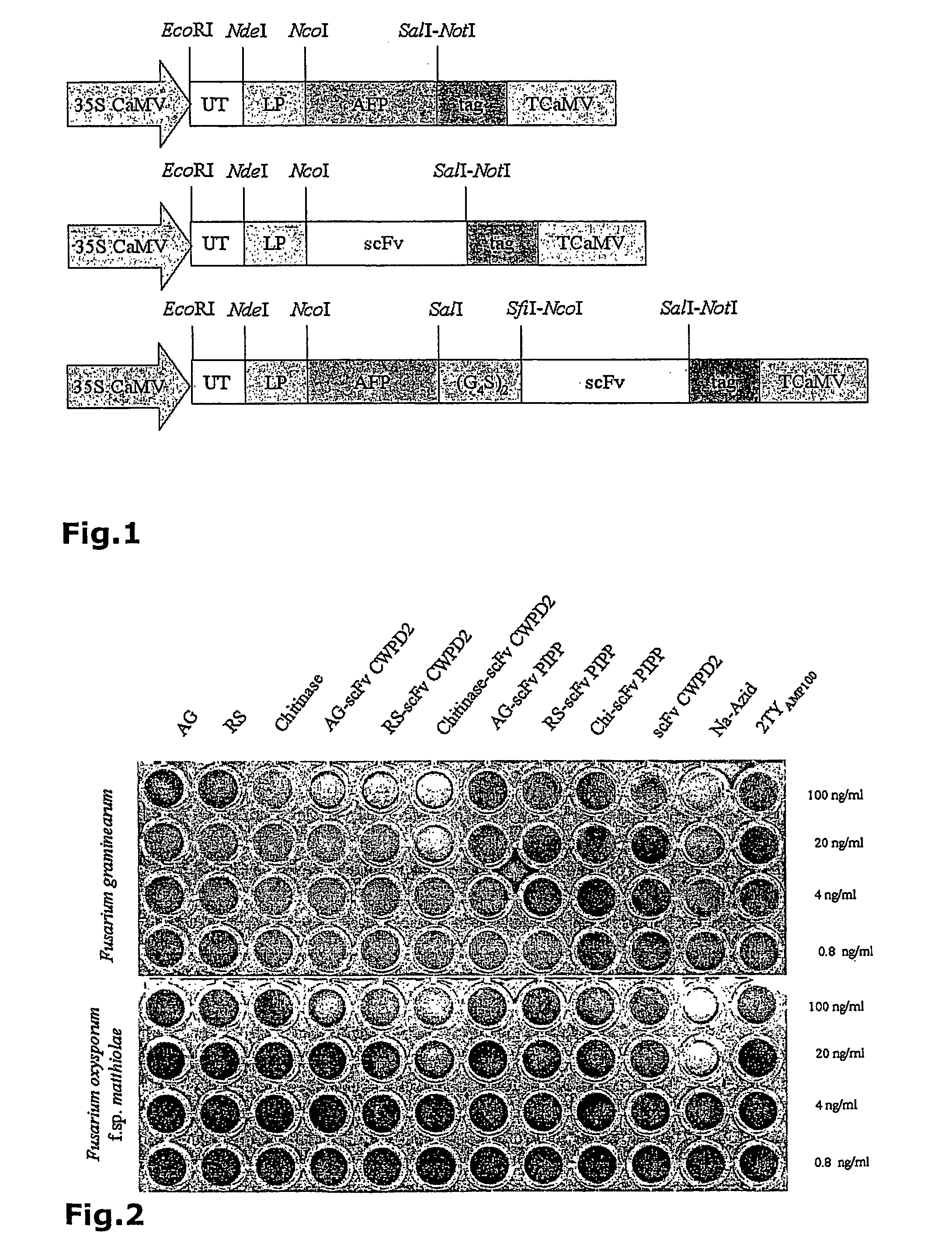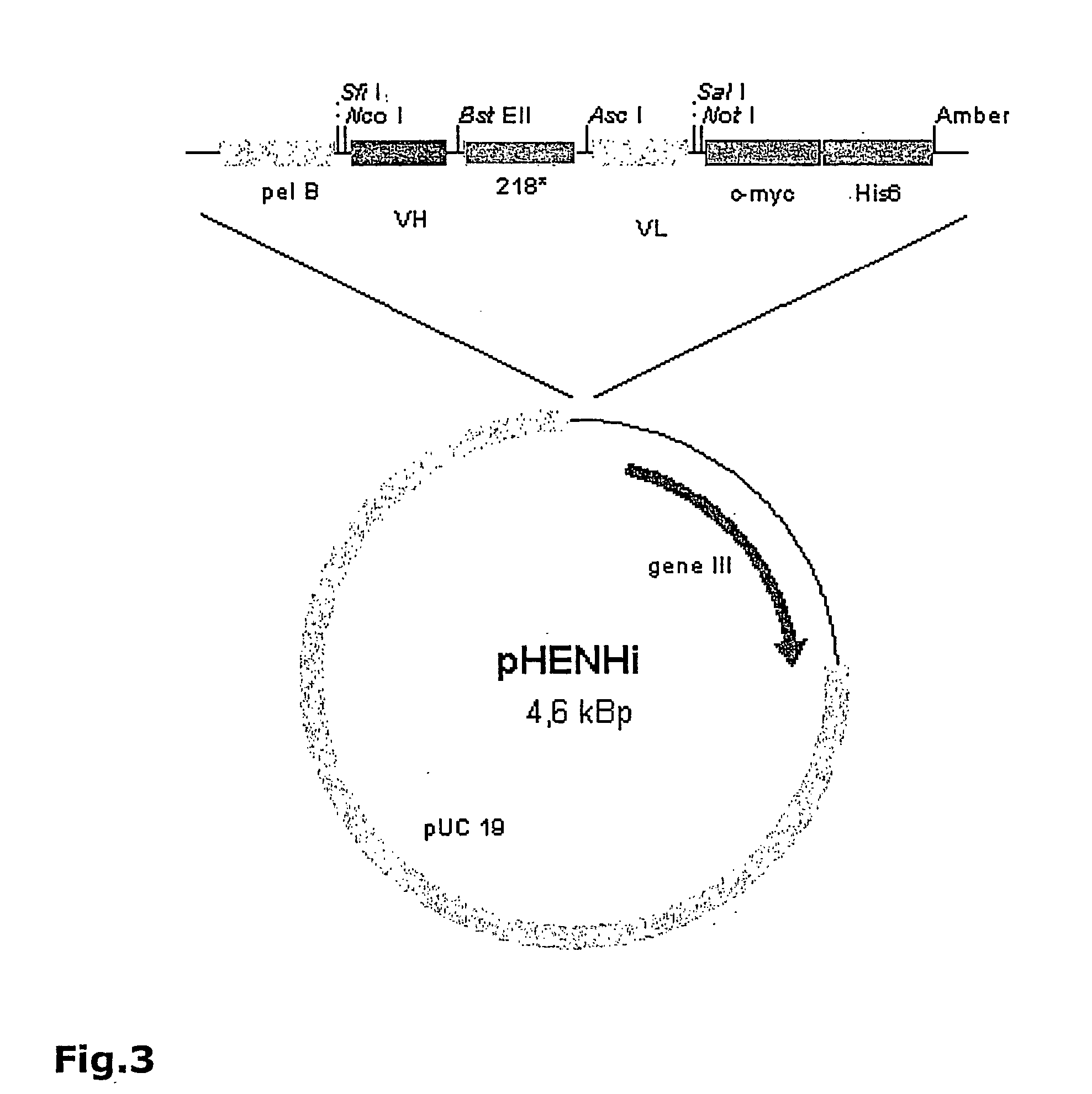Antibodies, recombinant antibodies, recombinant antibody fragments and fusions mediated plant disease resistance against fungi
a technology of plant disease resistance and fusion, which is applied in the field of antibodies, recombinant antibodies, recombinant antibody fragments and fusions mediated plant disease resistance against fungi, can solve the problems of large economic loss, undesirable environmental consequences, and major threat of plant disease to human food stocks and animal feed, and achieves the effect of effective and environmentally sensitive manner
- Summary
- Abstract
- Description
- Claims
- Application Information
AI Technical Summary
Benefits of technology
Problems solved by technology
Method used
Image
Examples
example 1
Generation of Fusarium-Specific scFvs by Hybridoma Technology
[0072] 1. Antigens (secreted proteins from fungal hyphae) were prepared from Fusarium graminearum.
[0073] 2. Mice were separately immunized with the antigens.
[0074] 3. Spleen cells from immunized mice were isolated and hybridomas were generated. Several limiting dilution steps were performed to isolate hybridoma cell lines that secrete antibodies specifically recognizing fungal antigens.
[0075] 4. mRNA from selected hybridoma cell lines was isolated and cDNA generated using reverse transcriptase. cDNA sequences encoding the antibody variable heavy and light chains (VH and VL) were amplified by PCR and cloned into the pHEN4II and pHENHi vector.
[0076] 5. The final scFv construct scFv SPIII7 (Seq. ID. No. 4) was used for bacterial and plant expression.
example 2
Generation of Fusarium-Specific scFvs by Phage Display
[0077] 1. Antigens were prepared from Fusarium graminearum. The following antigens were prepared: cell wall proteins, germinated spores and fresh plate culture washing proteins.
[0078] 2. Chicken were immunized separately with the antigens.
[0079] 3. mRNA from chicken spleen cells was isolated and cDNA generated using reverse transcriptase. Variable domains of heavy and light chains (VH and VL) were amplified by PCR and cloned via unique restriction sites separately into the phage display vector pHENHi (FIG. 3) to generate a VH and a VL library, pHENHi contained a pelB signal sequence for targeting of recombinant proteins to the bacterial periplasm and a C-terminal c-myc (Seq. ID. No. 20) and his6 tag (Seq. ID. No. 21). Subsequently, VL fragments were cut out from the VL library and ligated into the VH library to assemble the scFv cDNA whereas VH and VL cDNAs were connected by a linker peptide. The libraries obtained from the c...
example 3
Characterization of scFvs
[0082] 1. ScFv CWPD2 (Seq. ID. No. 1), scFv FPCWPA5 (Seq. ID. No. 3), scFv SGB3 (Seq. ID. No. 2) and scFv SPIII7 (Seq. ID. No. 4) cDNAs from the examples 1 and 2 in PHENHi were bacterially expressed, purified by IMAC and characterized by immunoblot, ELISA and immunofluorescence microscopy.
[0083] 2. Integrity of purified scFvs was verified by immunoblot.
[0084] 3. ELISA confirmed that the scFv CWPD2 (Seq. ID. No. 26), scFv FPCWPA5 (Seq. ID. No. 28), scFv SGB3 (Seq. ID. No. 27) and scFv SPIII7 (Seq. ID. No. 29) including cmyc (Seq. ID. No. 45) and his6 tag (Seq. ID. No. 46) bound to all three fungal antigens, cell wall proteins, germinated spores and, fresh plate culture washing proteins. They bound to the surface of germ tubes and mycelia from different Fusarium ssp., e.g. F. graminearum, F. culmorum, F. solani, F. oxysporum f.sp. cyclaminis, F. oxysporum f.sp lycopsersici and F. oxysporum f.sp. matthiolae.
[0085] 4. Immunofluorescence microscopy verified ...
PUM
| Property | Measurement | Unit |
|---|---|---|
| nucleic acid sequence | aaaaa | aaaaa |
| nucleic acid | aaaaa | aaaaa |
| resistance | aaaaa | aaaaa |
Abstract
Description
Claims
Application Information
 Login to View More
Login to View More - R&D
- Intellectual Property
- Life Sciences
- Materials
- Tech Scout
- Unparalleled Data Quality
- Higher Quality Content
- 60% Fewer Hallucinations
Browse by: Latest US Patents, China's latest patents, Technical Efficacy Thesaurus, Application Domain, Technology Topic, Popular Technical Reports.
© 2025 PatSnap. All rights reserved.Legal|Privacy policy|Modern Slavery Act Transparency Statement|Sitemap|About US| Contact US: help@patsnap.com


